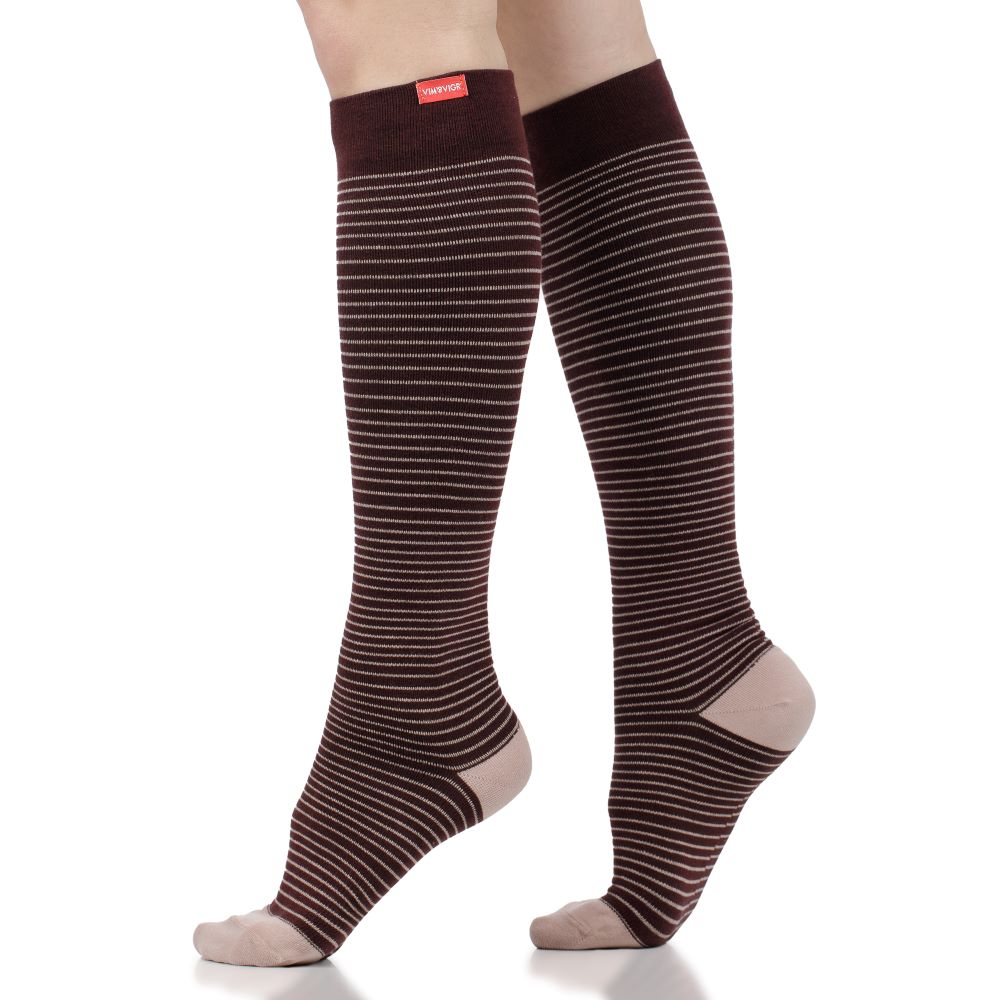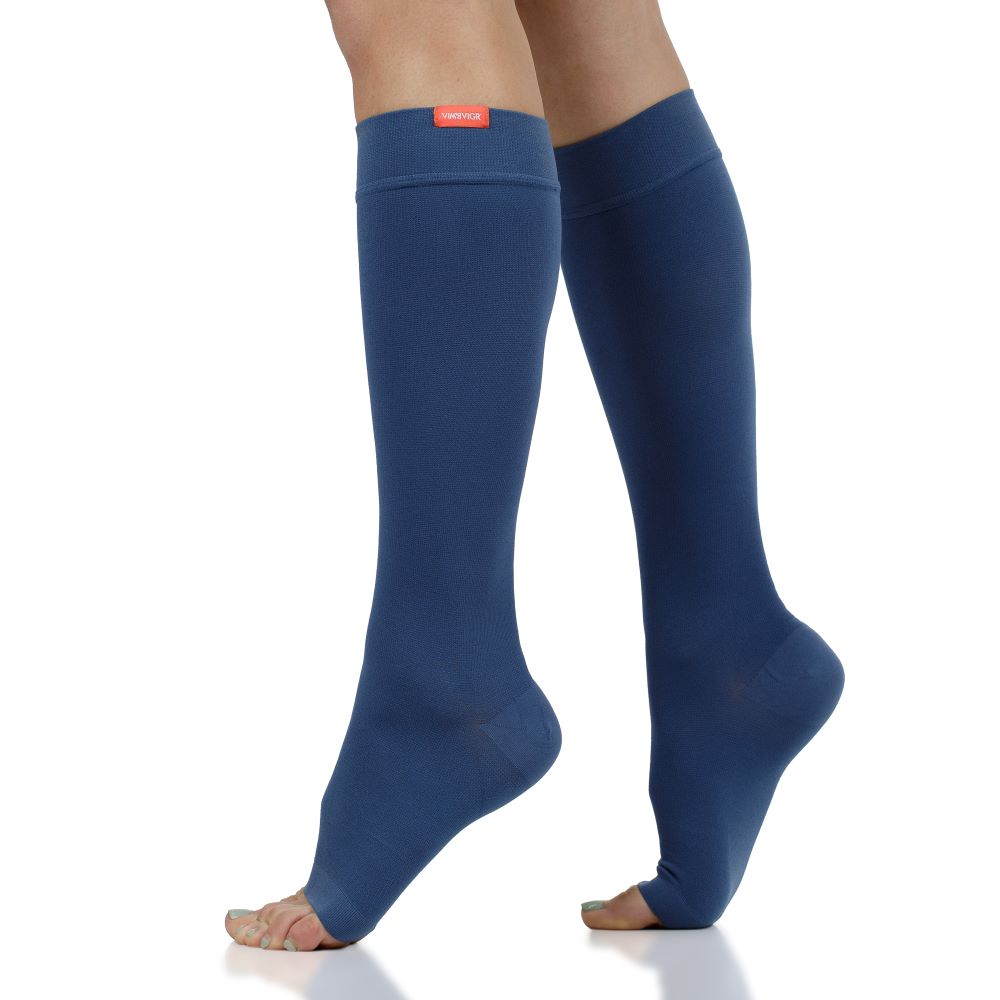Economy Class Syndrome: Causes, Symptoms, and Solutions
Scientifically Reviewed by Daniel Chantigian
Have you ever heard of economy class syndrome? This refers to when people on long-haul flights experience problems with peripheral circulation or even thrombosis. It is also known as traveler’s thrombosis. Economy class syndrome often causes more severe thrombotic events like deep vein thrombosis (DVT), although many people suffer from the latter without going on economy class flights. And, of course, those traveling in more spacious seats like in business or first class can also encounter circulatory problems.
So, what is economy class syndrome, what causes it, and can you avoid it? In this article, you will learn how long-haul flights and a lack of movement during them can spell trouble for your lower limbs. To reduce your risk for developing economy class syndrome, we will give you solutions to help you prevent or manage economy class syndrome.
What is Economy Class Syndrome?
The term “economy class syndrome” refers to thrombosis that may occur during long-haul flights, which primarily happen to passengers in economy class per one report. Thrombosis is a condition where one or more blood clots form in the blood vessels that lead to narrowing or blockages of the blood vessels. This is extremely serious. If a blood clot causes a blockage in a critical area of your body, it can become life-threatening. Blood clots due to thrombosis can lead to strokes or heart attacks.
Thrombosis can occur when traveling in economy class because of factors like:
- Lack of movement
- Low humidity
- Hypobaric hypoxia (when the partial pressure of oxygen is reduced, which can cause lower oxygen saturations in humans)
However, as a 2017 study highlights, economy class syndrome is also influenced by the passenger’s risk factors. These include if they are overweight, taking oral contraceptives, or have other medical or physical conditions.
The Relationship Between ECS and DVT
Researchers identified a connection between sitting for extended periods of time and the development of venous thromboembolism (VTE) - which encompasses deep vein thrombosis (DVT) and pulmonary embolism (when a blood clot blocks a vessel in the lungs). DVT is sometimes referred to as economy class syndrome, but it is only one part of the problem. It is also important to know that long periods of inactivity, like sitting without moving for hours, cause the blood pool in the lower limbs, and this can lead to DVT or VTE even if you are not on a long plane flight.
Moreover, simply traveling in business class does not keep you safe from blood flow issues and the risk of developing DVT. Business class sections of a plane present the same environmental risk factors of reduced air pressure and low humidity. Also, having more legroom is not enough if you don’t get up and walk or stretch regularly. In fact, the CDC warns that anyone traveling long-distance, by plane, car, bus, or train, can be at risk of blood clots.
Causes of Economy Class Syndrome
So, what exactly causes what we define as economy class syndrome? Here are individual risk factors to help you identify them and prevent them (if possible) regardless of your location or mode of travel.
Prolonged Immobility
Sitting still, without moving your legs, can cause blood to pool in the lower extremities. This leads to circulatory issues and, most notably, to an increased risk of blood clots forming in the legs, according to the Mayo Clinic. If blood clots form in deep veins, then you have deep vein thrombosis. The longer your flight or period of immobility, the longer the time blood will pool in your lower limbs to cause swollen legs and feet. You may start to notice blood pooling if you begin to feel discomfort in your lower limbs, which can feel like pins and needles or numbness.

Reduced Cabin Pressure and Partial Pressure of Oxygen
The lower cabin pressure experienced specifically in planes plays a role in causing economy class syndrome. At sea level and normal air pressure of 760 mmHg, oxygen saturation is 95% in healthy individuals. However, at flight altitude, cabin pressure is usually around 570 mmHg, which causes oxygen saturation to decrease to 90-93%, according to one scientific report. This environment may increase the risk of blood clots forming. Hypobaric hypoxia prevents the
Dehydration
According to a 2019 study, low hydration levels (also called hypohydration) can cause your blood vessels to narrow and have worse function. This is known to cause poorer circulation. We often hear about people feeling dehydrated on planes, which can be caused by low humidity inside planes (approximately 10% compared to 30-40% at sea level).
Pre-Existing Risk Factors
We’ve discussed above that economy class syndrome is also dependent on a person’s specific medical or physical choices. People who take oral contraceptives may have a higher risk of suffering from a thrombotic event, according to one study.
Moreover, scientists have found that people with obesity are more likely to experience a reduction in blood flow in the lower limbs during air travel, which is associated with an increased risk of a thrombotic event. Additionally, there is a genetic predisposition, called thrombophilia, which increases the risk of blood clots.
There are other risk factors for economy class syndrome or thrombotic events during travel listed by the University of Michigan. These include recent surgery, smoking, history of cancer, or pregnancy.
Economy Class Syndrome Symptoms
If you’re wondering what it’s like to go through economy class syndrome, here are the most common symptoms.
Leg Pain and Swelling
As blood has more difficulty traveling upwards from the lower limbs, it will begin to pool in the lower legs, ankles, and feet. This leads to swelling and inflammation around the ankles and lower limbs. You may begin to notice tingling sensations around the ankles and feet and perhaps even localized pain.

Redness and Warmth in the Affected Area
With blood pooling in one place, it can increase inflammation, which can radiate warmth and will be visible through redness on the skin and mild swelling. In more severe cases, DVT and pulmonary embolism together can also cause a fever, which will contribute to the feeling of warmth.
Difficulty Breathing and Chest Pain in Severe Economy Class Syndrome
Changes to your heartbeat or even chest pain have also been identified as severe economy class syndrome symptoms. Shortness of breath is known as the most common symptom. It is also possible that you may experience anxiety and cold sweats.
How to Prevent Economy Class Syndrome
There are ways to reduce the risk of economy class syndrome, especially by choosing methods that can boost blood flow and help you stay as active as you can during your travels.
Wear Graduated Compression Socks
Graduated compression socks are tighter at the ankles, slowly releasing pressure as they climb towards the knee. This stimulates blood flow out of the lower limbs. This reduces the risk of blood pooling in one spot and causing swelling around the ankles.
Researchers published a scientific report in 2021 which stated that compression garments, like compression socks, reduce the risk of deep vein thrombosis.
It’s safe to wear compression socks for as long as you feel comfortable. We recommend familiarizing yourself with them before your flight, starting with wearing them a few hours at a time. They are convenient and comfortable, and you can take them anywhere you go.

In-Flight Movement and Exercise
In addition to boosting peripheral circulation while you’re sitting down, try to get up regularly to stretch your legs. This can be as simple as walking up and down the aisle a few times. If you’re feeling comfortable enough, do some knee rotations and even a few squats while you wait in line for the toilet. Rotating your arms and neck is also great for releasing tension in the rest of the body.
Additionally, you can do some stretches while you’re sitting to help stimulate some blood flow. Just like when you’re stuck sitting at your desk for a long time, rotate your ankles clockwise and counterclockwise a few times, then point your toes and move your feet up and down. If you can bring a small tennis ball with you on your flight, it may even be beneficial to remove your shoes and give yourself a foot massage for 5 minutes on each leg (assuming your seat neighbors are ok with it!).
Self-massage is another way to support your lower limb blood circulation in-flight. Massage your calf muscles and shins gently, moving upwards from the ankles. You will feel some tension relief in addition to the decrease in swelling and discomfort.
Hydrate
Since dehydration makes circulation more difficult, make sure you keep drinking water when you’re on a long flight. Sip water regularly, rather than drinking a lot at one time.
Avoid Excessive Alcohol and Caffeine Consumption
The UK National Health Service warns that alcohol consumption increases your risk of economy class syndrome. Although a glass of wine may feel tempting to lure you to sleep during your flight, limiting alcohol intake will get you to your destination in a better shape instead. Caffeine and alcohol are also diuretics and can contribute to dehydration - so try to avoid both.
Choose Light, Nutritious Meals
To ensure you feel good and support a healthy circulation during long flights, a light and healthy meal is also a good idea. Try to steer clear of very salty foods which can contribute to blood pooling and clotting. If you can, bring some fresh fruits or low-salt foods with you to snack on.
Talk to Your Doctor About Medications and Supplements
Vitamins and minerals contribute to your overall health and can prevent traveler’s thrombosis. However, individual requirements vary depending on your personal health history. Talk to your doctor about what may help.
Monitoring for Signs of Economy Class Syndrome or Thrombosis After Landing
After landing, you are not necessarily free of risk when it comes to deep vein thrombosis or blood clots. This is because the conditions that have led to poor peripheral circulation and the potential formation of clots will make their impact felt for longer. Monitor your legs, in particular the feet and ankles, to see if they get very swollen or sore. It’s a good idea to wear compression socks after your flight to keep stimulating peripheral blood flow.
Any shortness of breath or fever should be treated with caution. You should see a medical professional right away and explain your circumstances so they can diagnose you quickly.
References
Dusse, L. M. S., Silva, M. V. F., Freitas, L. G., Marcolino, M. S., & Carvalho, M. D. G. (2017). Economy class syndrome: what is it and who are the individuals at risk?. Revista brasileira de hematologia e hemoterapia, 39(4), 349–353. Read it here.
Ashorobi D., Ameer M. A., & Fernandez R. Thrombosis. [Updated 2023 Aug 8]. In: StatPearls [Internet]. Treasure Island (FL): StatPearls Publishing; 2024 Jan. Read it here.
Gavish, I., & Brenner, B. (2011). Air travel and the risk of thromboembolism. Internal and emergency medicine, 6(2), 113–116. Read it here.
CDC. (2019). Blood Clots and Travel: What You Need to Know. Centers for Disease Control and Prevention. Read it here.
Mayo Clinic Staff. (2022). Deep vein thrombosis - Symptoms and causes. Mayo Clinic. Read it here.
Watso, J. C., & Farquhar, W. B. (2019). Hydration Status and Cardiovascular Function. Nutrients, 11(8), 1866. Read it here.
Martinelli, I., Taioli, E., Battaglioli, T., Podda, G. M., Passamonti, S. M., Pedotti, P., & Mannucci, P. M. (2003). Risk of venous thromboembolism after air travel: interaction with thrombophilia and oral contraceptives. Archives of internal medicine, 163(22), 2771–2774. Read it here.
Clarke, M. J., Broderick, C., Hopewell, S., Juszczak, E., & Eisinga, A. (2021). Compression stockings for preventing deep vein thrombosis in airline passengers. The Cochrane database of systematic reviews, 4(4), CD004002. Read it here.


















Leave a comment